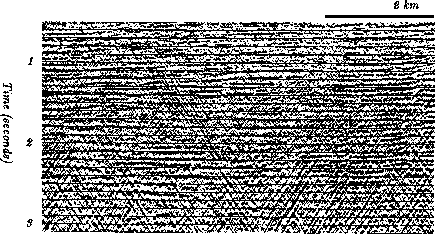 |
Figure 22 CDP stack with water noise from the Shelikof Strait, Alaska. (by permission from Geophysics, Larner et al. [1983])
At some locations, near-surface waves overwhelm the deep reflections of geologic interest. Compounding our difficulty, the near-surface waves are usually irregular because the earth is comparatively more irregular at its surface than deeper down. On land, these interfering waves are called ground roll. At sea, they are called water waves (not to be confused with surface waves on water).
A model for such near-surface noises is suggested by the vertical reflecting wall in Figure 13. In this model the waves remain close to the surface. Randomly placed vertical walls could result in a zero-offset section that resembles the field data of Figure 22. Another less extreme model for the surface noises is the flat-topped curves in the random point-scatterer model.
 |
In the random point-reflector model the velocity was a constant. In real life the earth velocity is generally slower for the near-surface waves and faster for the deep reflections. This sets the stage for some unexpected noise amplification.
CDP stacking enhances events with the stacking velocity and discriminates against events with other velocities. Thus you might expect that stacking at deeper, higher velocity would discriminate against low-velocity, near-surface events. Near-surface noises, however, are not reflections from horizontal layers; they are more like reflections from vertical walls or steeply dipping layers. But equation (4) shows that dip increases the apparent velocity. So it is not surprising that stacking at deep-sediment, high velocities can enhance surface noises. Occurrence of this problem in practice was nicely explained and illustrated by Larner et al. [1983]